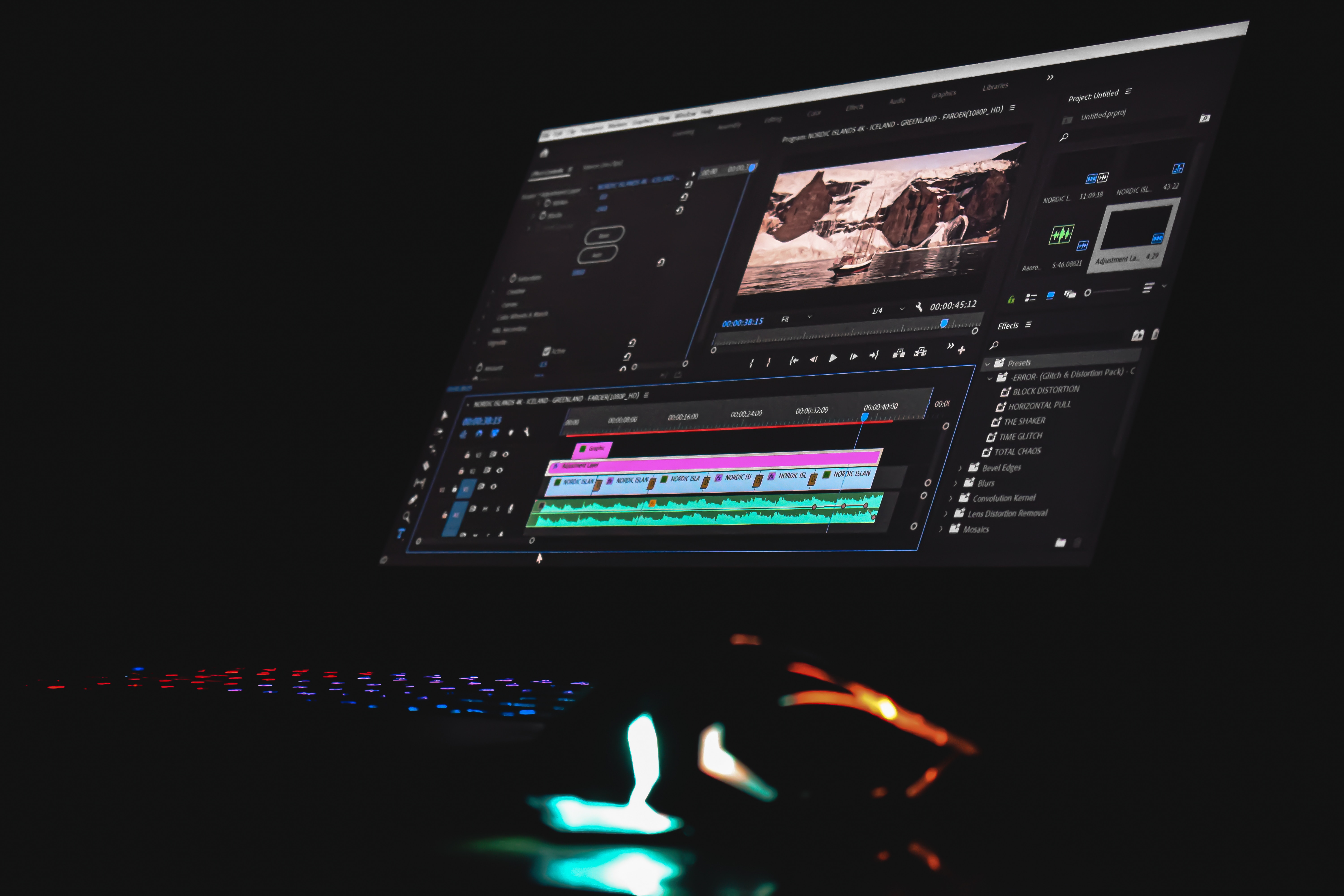Video post-production is complex, ranging in various steps, skills, and types of software. How your editing process looks will depend on your project's needs, including its runtime, graphics, and audio as well as where you plan to post it.
Continue reading to answer the oft-asked question, "How long does post-production take?"
What Is Post-Production?
Following pre-production and principal photography, post-production is the third primary stage in the movie- and video-making process. Depending on the project's size and needs, post-production usually comprises several steps, including:
- File sorting
- Determining the best footage, along with B-roll, sound bytes, and other assets
- Assembling the editor's cut
- Implementing revisions from the director, studio, and consultants
- Fine-tuning color correction, audio quality, visual effects, and timing
- Reshooting scenes, new content, and individual shots
- Utilizing test audiences, often with different cuts
- Working with a composer or adding royalty-free music
- Assembling the director's cut
- Assembling the producer's cut
- Adding subtitles and language dubs
- Implementing a marketing and release plan
This multifaceted stage of the filmmaking process often comprises multiple artists, from the lead editor to the sound post-production team. Because of this, post-production timelines can vary widely depending on the specifics of the project.
For instance, a music video with basic color, audio, and timing demands may take under two weeks to edit, depending on the editors' schedules. On the other hand, a lengthy, CGI-heavy TV series could take a year or more to edit. Despite these lengths, many projects, such as last-minute reshoots and 24-hour film festivals, require some projects to be fully edited overnight.
Professional post-production studios must often work on tight deadlines and understand various editing processes to meet demanding production schedules. Even independent content creators should learn different practices to make their post-production videos stand out.
Essential Elements of the Post-Production Process
Post-production video editing is an extensive process with various steps and strategies. Below are some of the most critical phases of the process to help you gauge how long movies take to make.
Organizing Shoots
Efficient post-production in film begins with dependable organization of assets, from your video footage to graphics files. Your specific organization method and labels often depend on your preferences and what works best for your workflow, especially when working alone. However, your folder names should still be easy to understand so potential collaborators know what they're working with.
Most editing teams sort their footage by their production date, followed by their card number. So, inside a folder labeled "3/27/23 FOOTAGE," you might find the following additional folder names:
- VIDEO CARD 01
- VIDEO CARD 02
- AUDIO CARD 01
- AUDIO CARD 02
- ROOM TONE
- GRAPHICS
- ASSETS
- SCRIPT SUPERVISOR SCREENSHOTS
Many virtual production teams use specialized digital imaging technicians (DIT) to store and sort footage on set, such as when switching camera batteries. By immediately transferring and labeling video files, you avoid losing footage from corrupted or lost cards. Additionally, having a designated DIT gives them more time to verify transfers, create backups, and organize files. Talk with your production managers to check your video storage plan and discuss options for an on-set DIT.
Capturing Audio
Sorting audio usually consists of matching sound files with their matching video files and identifying additional assets, such as room tone and royalty-free music. Many production teams use timecode devices that attach to their cameras and audio equipment. By setting everything to the same timing, you can skip the hassle of matching dialogue to lip movement later. Instead, capturing and matching audio with video is as easy as putting them on the same timeline and clicking "Sync."
Room tone, or the roughly 30-second blips of audio recorded on set, goes a long way in audio post-production. The best room tone is recorded at the beginning, end, and sometimes middle of every location shoot. This way, the editor can play with the sound's different pitches and accents to blend the audio more fluidly. So, if a refrigerator turns on in the middle of a high-quality shot, they can seamlessly replace the fridge's hum with another ambient tone.
Collection of Raw Footage
Editors can't jump immediately into every project. The director's preferences for each shot should be the most significant factor when selecting footage. As such, the creative leads should be actively involved at the beginning of post-production editing to choose the best footage and give directions.
Script supervisor and dailies notes can help simplify this process by indicating which raw footage the director liked on the day. While the director and editor should still comb through the files later, "scripty notes" give editors better guidelines for assembling early cuts. As you sort through, consider splicing clips and adding tags along your timeline to designate the best bytes.
Visual and Special Effects
Your special and visual effects (VFX) needs will depend on your specific project, such as whether you primarily need animations or motion graphics. For post-production, your primary focus will be on visual effects, as most special effects are performed practically and may only require some smooth editing. That said, the complexity of visual effects varies drastically, and their limitations often depend on your skills, resources, and budget.
Some of the most complex VFX sequences can be performed entirely on your own if you have the patience to learn. For example, the 2023 Best Picture winner, Everything Everywhere All at Once, had a VFX team of just seven that used YouTube tutorials for the movie's biggest sequences. However, depending on your project, it may be better to outsource your effects needs to VFX specialists to guarantee quality and save time.
Sound Editing
Assembling a high-quality soundtrack involves more than matching timecodes and ensuring you can hear everyone. Depending on your audio's condition, you may need to erase background noise, add additional sound effects, or replace dialogue altogether.
While the audio's quality shouldn't be your priority during the first few cuts, it will become important once your timelines stop shifting. As you edit, keep an eye on the following audio factors:
- Muffled or interrupted dialogue
- Background noises, such as from appliances, traffic, and neighbors
- Audio cracks or other technical issues
- Empty areas that could use royalty-free music and sound effects
Depending on your skills, some projects will need the assistance of a professional sound designer. These video editors will tweak, fine-tune, and recommend the best steps for your project's audio, though the process may be costly and timely. Other issues may require reshoots or automated dialogue replacement (ADR) to replace the footage entirely.

Different Types of Projects and Average Time of Post-Production
The general, often-disputed rule of thumb is that one minute of basic footage takes one hour to edit. This doesn't refer to CGI-heavy blockbusters or B-roll-leaning music videos, but rather standard documentaries and short films with minimal needs. However, the estimated hour often doesn't include the time for color grading, rendering, or revising — only editing one minute of the roughest cut.
The "one minute to one hour" ratio is the simplest estimation for post-production time, but by understanding the variables at play you can assemble a dependable editing schedule.
Short Videos for Social Media
Short social media videos are usually the easiest and quickest projects to edit as they often don't require many cuts and most platforms make the process easier. So, depending on the specifics of your project, a one-minute social media video could take anywhere from five minutes to one hour to edit. However, much of that time may be dedicated to adding captions, hashtags, and keywords.
Long-Form Videos for Social Media
Longer social media videos tend to rely on more motion graphics, B-roll, and other assets to retain the audience's attention long-term. So, while projects with simpler needs often follow the "one minute to one hour" ratio, more complex projects and graphics could take a week or more to piece together.
Factors that often add time to social media video post-production include:
- Text and other graphics
- B-roll and heavy amounts of footage
- Visual and special effects
- Poor post-production software
- Rendering multiple formats, such as for different platforms' aspect ratios
- Finding high-quality music that meets social media standards
Shorts and Films
Whether they're short or feature films, studio or indie, genuine film projects require extensive care to ensure the best quality possible. Each step of the post-production process, from color grading to refining sound, includes endless time variables. The best strategy for your post-production schedule is to consider all of your project's editing needs — including color, music, and effects — during the pre-production phase.
A five-minute short film may follow the "one minute to one hour" ratio for the standard rough cut, though only for that process stage. Assuming the short film doesn't need extensive effects, its full post-production schedule could look like this:
- Collecting and organizing footage: Two hours
- Editing footage into rough cut: Five hours
- Coloring footage: Two hours
- Editing audio: Three hours
- Locating and adding music: Two hours
- Playthroughs and revisions: Three hours
- Rendering One hour
- Contingency: Five hours
- Total time: 23 hours
Incorporate Royalty-Free Sound Effects Into Your Video Production
Working with catchy music can help guide the timing of your edits and make your finished products stand out. Now that you've answered the question, "How long does post-production take?" you can simplify many steps by investing in a royalty-free music license.
Whether you're preparing for a social media post or theatrical release, explore our expansive audio library to find the right music for your project.




